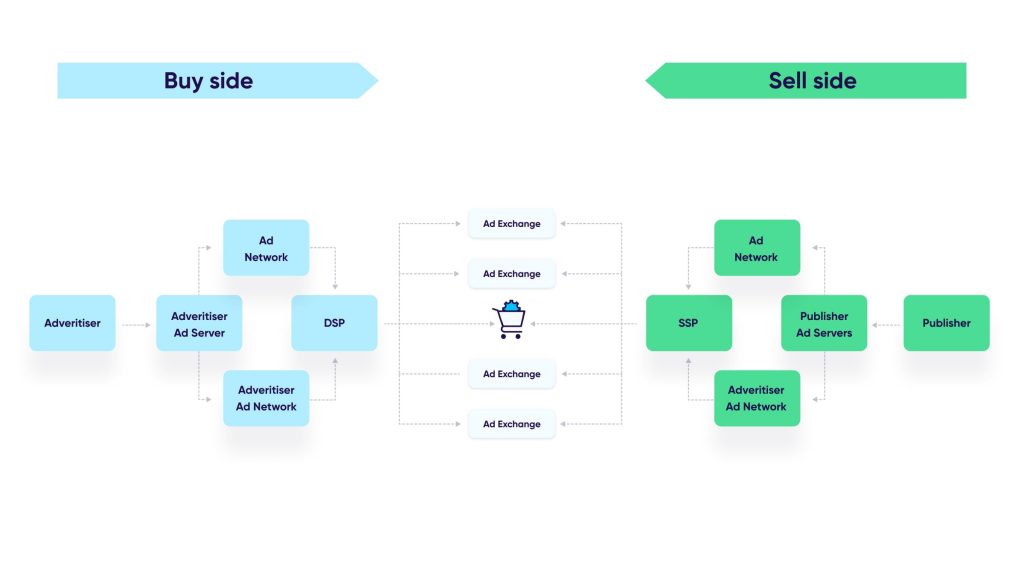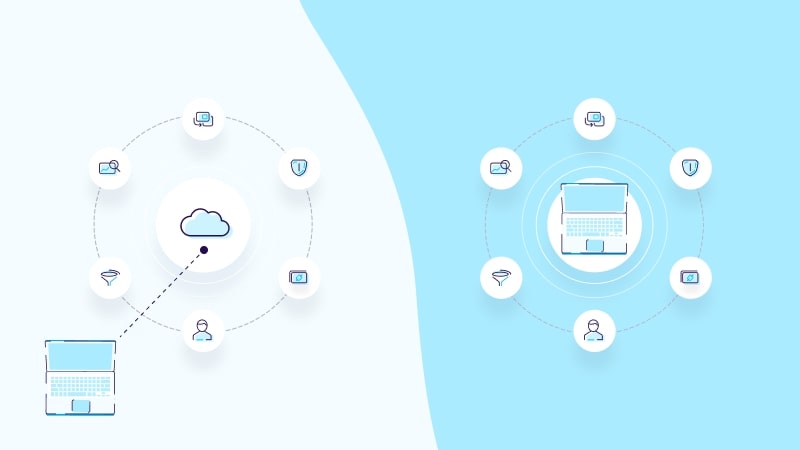
Ad server
An ad server is a software platform that manages the distribution of digital advertising campaigns.
What is an ad server?

An ad server stores variations of an ad campaign’s creative assets, such as imagery, audio, and video files, and selects which versions to serve which customers. Ad servers also have the ability to collect data, such as clicks and number of impressions, that provides insight into an ad’s performance.
In the milliseconds it takes a page to load, an ad server picks the right ad to shoot in a mobile app or website’s available ad slot by choosing from its reserve of available ads.
Ad servers are data-driven matchmakers that connect ads with audiences based on a set of descriptive tags on geolocation, interests, and behaviors. For example, if an ad is about outdoor gear, the ad server looks for people whose data indicates they’re interested in hiking.
These sophisticated algorithms rely on decision-making criteria that include multiple targeting variables, the frequency with which an ad is presented, where and in what format it’s displayed, and its earning potential.
How does an ad server work?
To meet the growing demands of the digital marketing industry, ad servers evolved past their primary function of ad storage and delivery to include real-time decision-making capabilities and campaign performance insights.
This understandably causes some confusion on how ad servers’ capabilities relate to other ad tech platforms.

Ad servers are different from ad networks, which aggregate certain publishers’ inventories of available ad spaces and broker their sale to advertisers.
The key difference between programmatic vendors (ad networks / exchanges / SSPs / DSPs) and an ad server – is that an ad server enables the management of all assets.
For publishers, it allows them to serve and manage all ads – direct, internal promotions (house ads), and multiple programmatic vendors. For advertisers, ad servers enable them to perform creative management and measure ads that are served on different publishers’ apps or websites.
When advertisers purchase the inventories, they can upload their creative assets to the network’s ad server. Then, when the ad server receives the request from a publisher’s website or mobile app, it can generate the appropriate attribution tags and display the right ad in the right slot to the right user, all from a central location.
Many ad servers are bundled with demand-side platforms (DSPs) – the interface through which advertisers buy inventory from publishers. A DSP relies on an ad server to store creative assets and serve ads to a website / mobile app.
Likewise, an ad server without a DSP does not allow advertisers to connect to the programmatic ecosystem, where they could participate in automated real-time bidding (RTB) auctions for ad placement.
Ad servers without the interface of a DSP (or an SSP or sell-side platform, where publishers manage their inventory of ad space) conduct what’s referred to as a “direct deal.”
This means that a publisher sells their inventory directly to an advertiser, negotiating the terms through a more traditional and manual media buying relationship.
In a direct deal, the publisher’s and advertiser’s ad servers communicate with each other to deliver ads to the publisher’s website or app visitors. Interestingly, though the technology is the same, publishers and advertisers use ad servers in different ways.
Types of ad servers
There are two main types of ad servers:
- First-party (publisher-side)
- third-party (advertiser-side)
Both have the same technical capabilities but are used for slightly different ends by each party.
A simple way of looking at it is that publishers use ad servers to directly control where and to whom their ad inventory is being served, whereas advertisers use ad servers as a means of aggregating and auditing campaign information across all of the networks and publishing platforms an ad runs on.
Let’s take a closer look at each.
First-party (publisher or sell-side)

Publishers use ad servers to manage their own inventory and to measure and report which advertisers’ campaigns deliver the highest value in terms of revenue and conversions.
First-party ad servers allow publishers to manage ad slots on their own websites / apps and display ads that have been sold directly to advertisers.
Publishers’ ad servers are capable of analyzing user data, such as geolocation, language, and online behavior, plus available demographic attributes from consenting users, such as age and gender.
In parallel, the servers process the business rules that determine which ads can appear in which slots and establish the bidding priority on which advertisers will be able to fill them. With consideration to this data, the servers then select the best ads from the highest-value advertisers to display in the available ad slot.
In terms of measurement , first-party servers are primarily concerned with how an ad performs in a particular placement on the publisher’s website / mobile app.
Third-party (advertiser or buy-side)
Third-party ad servers are a means for advertisers to indirectly interact with multiple publishing platforms, allowing them to store, serve, and measure multiple variations of active ad campaigns.
Advertisers tend to use their ad servers as an efficient way of testing and optimizing creative variations and measuring the results of campaign deliveries across placements.
Third-party ad servers offer advertisers several advantages:
- Advertisers can better manage their creative assets without needing to make updates with the publishers.
- They can develop templates to more efficiently generate new creatives that meet disparate requirements across publishing platforms.
- They can test multiple variations of the same campaign to see which version performs most effectively with which targeted audience and on which platform.
- Advertisers can optimize campaign delivery in real-time.
- They can apply frequency capping to limit the number of times a single piece of campaign creative is shown to a user.
- They can spread their ad spend evenly over placements in a given timeframe.
- Advertisers can collect detailed data about campaign performance across all of their placements.
- This creates more transparent and accurate reporting than relying on each publisher’s data.
- It allows the measurement of traffic and engagement across multiple sources to optimize future spend.
- It centralizes key metrics and insights in one place for efficient reporting.
Hosted vs. self-hosted servers

The difference between hosted and self-hosted ad servers is fairly straightforward; Hosted servers are maintained and run by an external service provider. Self-hosted platforms are installed and maintained by the user.
Choosing which suits your needs is down to control, cost, speed, and ease of use.
Hosted servers
- Pros
- Little technical knowledge is required as the hosting company does the heavy lifting and provides training and support.
- Provider monitors your server’s speed and reliability and is accountable for managing any issues that arise.
- Cons
- Higher-touch service comes at a cost.
- Partial data ownership – Limits control in terms of ability to customize.
Self-hosted (or open-source) servers
- Pros
- One-time setup fee, with the ongoing cost of server maintenance.
- Full data ownership – A fully customizable front and back end.
- Cons
- Requires dedicated technical expertise for installation, customization, and support.
- An open-source server may lack the features you need, requiring additional plug-ins to run desired functionalities.
Ad server platforms
There are numerous options available for first- and third-party ad serving platforms, but there are a few names to know as useful benchmarks of scale and quality.
DoubleClick
Still considered to be the most popular option for publishers, DoubleClick was sold to Google in 2008 and rebranded as Google Ad Manager in 2018.
It effectively combined two services: DoubleClick for Publishers (DFP) and DoubleClick Ad Exchange (AdX). The platform also offers DoubleClick Campaign Manager (DCM) for advertisers and agencies.
OpenX
An integrated SSP (supply-side platform), OpenX combines an ad server with a real-time bidding exchange for programmatic ad placements.
Kevel
An open-source platform, Kevel counts several of the most highly trafficked websites in the world – think Reddit and Ticketmaster – as customers.
What differentiates its unique DIY platform is that it offers a wide range of APIs for building highly customized ad server solutions for publishers and advertisers, which means it requires dedicated internal expertise and management.
ironSource
ironSource is focused specifically on in-app advertising in the mobile gaming industry.
And you might already be familiar with Google’s and Facebook’s self-serve ad platforms. Advertisers, small businesses in particular, can log in and set up their own ads and campaign management.
How to decide which ad server is right for you

To a certain extent, your role and position in the market will steer you toward a solution that suits your business purpose. As you audit your specific needs, the most important thing to assess is how much time and effort you’re willing to invest in implementing a solution that serves your objectives.
Publishers will be looking for platforms that support rich media ad formats and offer self-serve account management for advertisers, and optimization tools that help prioritize high CPM (cost per mille) ads.
Advertisers will want to focus on conversion measurement, optimization enabled through A/B testing functionalities, robust analytics, and, potentially, APIs that enable sophisticated customization.
Finally, ad networks might be interested in white label solutions, custom permissions, and support for the most diverse selection of ad formats.
Key takeaways
- Like web servers, ad servers are engines working under the hood to power the digital advertising ecosystem. The ad-serving workflow is complex and comprises an extensive web of interdependent technologies.
When it’s running smoothly, you hardly notice the effort, but when something goes wrong, it has a tremendous ripple effect.
- Depending on your business purpose and needs, ad servers will use the same functional capabilities in different ways to help you manage the scope of your digital marketing efforts.
But whether you’re a publisher or an advertiser, an ad server can be a dynamic hub of operational efficiencies for managing your inventory, creative assets, and relationships.
- Owning your ad server means owning your data. In this way, your ad server is a central artery of business intelligence, processing critical information about your customers, your investments, and the measurements of your efforts within and across channels.
An ad server keeps this invaluable information in one place, where it can be put into action for key decision-making.



